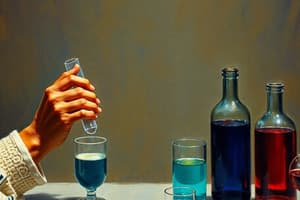Podcast
Questions and Answers
What is the first step in the Biuret test procedure?
What is the first step in the Biuret test procedure?
- Fill the test tube with water
- Shake the mixture well
- Combine 1 ml sample with 1 ml 10% NaOH (correct)
- Add a few drops of diluted CuSO4
What indicates a true coagulum in the Isoelectric Point (IEP) test?
What indicates a true coagulum in the Isoelectric Point (IEP) test?
- No precipitate forms
- A colored residue is formed
- The opaque mass dissolves in water
- The opaque mass does not dissolve (correct)
In the Fehling test, what color indicates that the reagent is ready for the sample?
In the Fehling test, what color indicates that the reagent is ready for the sample?
- Bright red
- Colorless
- Yellow
- Dark clear blue (correct)
What is used to neutralize excess acid after hydrolysis in the Fehling after hydrolysis test?
What is used to neutralize excess acid after hydrolysis in the Fehling after hydrolysis test?
During the Heat coagulation test, how should the sample be prepared in the test tube?
During the Heat coagulation test, how should the sample be prepared in the test tube?
What is the main function of the diluted CuSO4 in the Biuret using very diluted CuSO4 test?
What is the main function of the diluted CuSO4 in the Biuret using very diluted CuSO4 test?
What is the total heating time in the Fehling test before adding the sample?
What is the total heating time in the Fehling test before adding the sample?
What is the purpose of adding lead acetate in the Sulfur test?
What is the purpose of adding lead acetate in the Sulfur test?
What conclusion can be drawn if no violet color is observed in the Biuret test, but a violet ring appears in the Molisch’s test?
What conclusion can be drawn if no violet color is observed in the Biuret test, but a violet ring appears in the Molisch’s test?
What is indicated by a positive Biuret test after performing fusion with sodium hypobromide?
What is indicated by a positive Biuret test after performing fusion with sodium hypobromide?
If a sample turns blue when tested with red litmus paper, what does this suggest about the sample?
If a sample turns blue when tested with red litmus paper, what does this suggest about the sample?
What color result is expected from the iodine test when starch is present?
What color result is expected from the iodine test when starch is present?
What is the probable substance present if a red ppt is observed in Fehling’s test?
What is the probable substance present if a red ppt is observed in Fehling’s test?
If a sample exhibits no reddish-brown color in a ketose test, what does this suggest about the sample?
If a sample exhibits no reddish-brown color in a ketose test, what does this suggest about the sample?
In the scheme for identification of carbohydrates, what is associated with a violet color during the iodine test?
In the scheme for identification of carbohydrates, what is associated with a violet color during the iodine test?
What condition is indicated by no opaque mass in a heat coagulation test?
What condition is indicated by no opaque mass in a heat coagulation test?
If a sample shows a positive result in both the Biuret test and Fehling’s test, which conclusion can be drawn?
If a sample shows a positive result in both the Biuret test and Fehling’s test, which conclusion can be drawn?
Flashcards
Biuret test
Biuret test
A chemical test used to detect the presence of proteins.
Protein identification
Protein identification
Process to identify protein types using specific tests.
Carbohydrate identification
Carbohydrate identification
Process to identify carbohydrate types using specific tests.
Molisch's test
Molisch's test
Signup and view all the flashcards
Iodine test for carbohydrates
Iodine test for carbohydrates
Signup and view all the flashcards
Reducing sugars
Reducing sugars
Signup and view all the flashcards
NPN (Non-protein nitrogen)
NPN (Non-protein nitrogen)
Signup and view all the flashcards
Heat coagulation test
Heat coagulation test
Signup and view all the flashcards
Fehling's test
Fehling's test
Signup and view all the flashcards
Differentiation of proteins
Differentiation of proteins
Signup and view all the flashcards
Biuret Test Procedure
Biuret Test Procedure
Signup and view all the flashcards
Iodine Test Procedure
Iodine Test Procedure
Signup and view all the flashcards
Fehling's Test Procedure
Fehling's Test Procedure
Signup and view all the flashcards
Sulfur Test Procedure
Sulfur Test Procedure
Signup and view all the flashcards
Coagulation at IEP Procedure
Coagulation at IEP Procedure
Signup and view all the flashcards
Biuret Test with Diluted CuSO4
Biuret Test with Diluted CuSO4
Signup and view all the flashcards
Follin's Test Procedure
Follin's Test Procedure
Signup and view all the flashcards
Study Notes
Unknown Identification Scheme
- Biuret Test: Violet color indicates protein; no violet color indicates carbohydrate or non-protein nitrogen (NPN).
- Heat Coagulation Test: Opaque mass insoluble in dilute acetic acid indicates protein; no opaque mass indicates no protein.
- Molisch's Test: Violet ring indicates carbohydrate; no violet ring indicates no carbohydrate.
- Red Litmus Paper: Remains red indicates neutral protein; turns blue indicates alkaline protein.
- Albumin Test: Red litmus paper remains red; turns blue when reacting with alkaline solutions.
Additional Tests
- Sulfur Test: Used to differentiate proteins, with m-protein showing yellowish-brown color and casein showing a pale yellow color.
- Peptone, Gelatin, and Casein Tests: Specific tests used to identify these different protein types. Peptone shows a pink color using a very dilute copper sulfate solution in half saturation. Gelatin reacts with a violet color under the same conditions.
- Carbohydrate Tests: Uses iodine test to determine if a substance is dextrin or starch (blue color). Fehling's test determines reducing sugars by producing a red precipitate; sucrose gives no red precipitate. There are also specific tests (ketose test) to identify certain types of sugars.
Non-Protein Nitrogen (NPN) Tests
- No violet color with Biuret Test & No violet ring with Molisch's test: Indicates NPN.
- Red Litmus Paper: Remains red indicates NPN; turns blue indicates a specific NPN.
- Further Tests: For NPN, different tests may be performed to further identify the specific NPN.
Chemical Reaction Procedures
- Includes procedures for Molisch's test, Biuret test, iodine test, Fehling test, ketose test, and others. These procedures describe specific sample measurements (e.g., quantities of reagents, incubating times) and steps necessary to complete the specific test. This section also has procedures for heating/boiling, shaking, and adding reagents step-by-step.
Coagulation at Isoelectric Point (IEP)
- Procedure: Using samples and acetic acid stepwise for precipitate formation (IEP). The procedure involves heating the precipitate to determine if it is a true or false coagulum (solubility).
Biuret test using diluted CuSO4
- Procedure: Using diluted copper sulfate solution with a sample, followed by sodium hydroxide to identify specific substances through color changes.
Follin's Test
- Procedure: Procedure for using Follin's reagent with a sample to detect various substances.
Studying That Suits You
Use AI to generate personalized quizzes and flashcards to suit your learning preferences.




